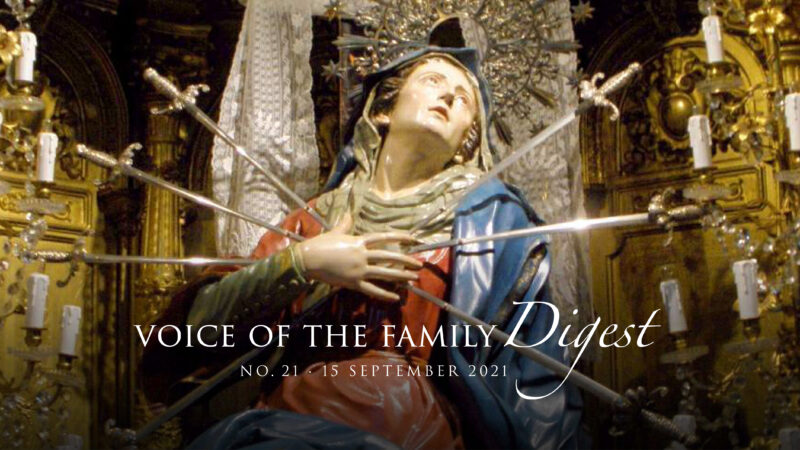Our Lady of Sorrows

15 September 2021
By Roberto de Mattei
On 15 September the Church celebrates the liturgical feast of Our Lady of Sorrows.
Sorrow belongs to Mary not in an episodic way but in a way we could call integral, because if Jesus is called Vir dolorum, according to the words of the prophet Isaiah (53:3), Our Lady could be defined as Mulier dolorum, the Lady of sorrows, the Mater dolorosa.
Jesus Christ, the Man-God, is called King of suffering and of martyrs because in his life he suffered more than all the other martyrs. His suffering was not just greater than that of every single martyr, but of all the martyrs combined in the course of history. Mary, a simple creature, suffered more than any other creature ever suffered. This immense suffering was prophesied to her by Simeon, who said to Our Lady: “A sword will pierce your soul” (Lk 2:34-35). The sword of sorrow pierced Mary throughout her life but reached its climax on Calvary. Mary’s presence in the hour of the Passion was, according to St Thomas, the greatest of all sorrows. (Summa Theologica, III, q. 46, a. 6).
The sufferings of Jesus were physical and moral. Mary’s sorrow was not physical, it was moral, and it was not limited to the moment of the Passion. When the Archangel Gabriel announced to Mary that she would conceive the Saviour, he also conveyed to her the nature and extent of the pains that her divine Son would face. And this was the deepest cause of her sorrow. In fact, if it is true that parents feel their children’s sufferings more than they do their own, this is true above all for Mary, since it is certain that she loved her son immensely, more than herself. Therefore her moral martyrdom lasted her whole life, from Nazareth to Golgotha. Mary, says Saint Alphonsus, spent her whole life in perpetual sorrow, with sadness and suffering always in her heart. The passage from Jeremiah applies to Our Lady: “Vast as the sea is your ruin” (Lamentations 2:13).
Jesus suffered in soul and body, Mary only in soul, but the soul is nobler than the body to which it gives life, and there is no comparison between the pain of the soul and that of the body.
Devout Catholics meditate on the Lord’s Passion, picturing the sufferings of Jesus on Calvary. But few meditate on Mary’s sorrows, which according to tradition were seven: the prophecy of Simeon, the flight into Egypt, the loss of Jesus in the temple, Mary’s meeting Jesus on his way to die, the death of Jesus, the blow of the spear and the deposition of Jesus from the cross, and finally the burial of Jesus. But we could add the sorrow of Holy Saturday, the day of supreme sorrow and supreme hope.
One of the reasons why there is little meditation on the sorrows of Our Lady is that relating to the sufferings of the body is easy, but it is hard to understand how great the sufferings of the soul can be. The lack of sensitivity to moral suffering is also due to the diminished capacity for love in the man of our time. In fact, the measure of suffering is love. The reason is clear because, as Saint Alphonsus says, quoting Saint Bernard, “the soul is more where it loves than where it lives”. He who does not suffer, we could say, does not love.
That is why the agonising sorrow that the soul of Our Lady suffered was born from her boundless love for her Divine Son, but also from her immense love for the Church and for each of us. Mary suffered because she loved us. For this reason, at a time when the Church is suffering through a process of appalling self-destruction, we must ask for the grace to love the Church and suffer with her. He who loves the Church suffers with her, and he who does not suffer with the Church shows that he does not love her.
Suffering with Mary for the Church also means fighting to defend the name of Mary and of the Church in the hour of humiliation and betrayal. And it is a devotion to Our Lady of Sorrows that disposes us to receive this grace.
RadioRomaLibera, 14 September 2020
